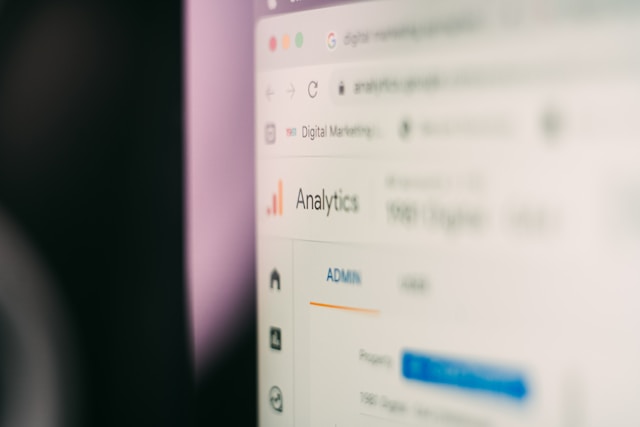Last Updated on August 1, 2024 by Richard Martin Linga
Web analytics is crucial for any business with an online presence. It helps you understand how visitors interact with your website. In other words, it provides data on user behavior. This data can help you make better decisions for your site. For instance, you can see which pages are popular and which need improvement. Therefore, web analytics is an essential tool for growth. At SEO Specialist Philippines, we emphasize the importance of web analytics to ensure our clients get the most out of their online presence.
In addition, web analytics allows you to track your marketing efforts with the help of SEO specialists in the Philippines who use web analytics to help businesses optimize their strategies and achieve better results. You can see which campaigns bring in the most traffic. So, you can focus on what works best. Above all, it helps you measure success and identify areas for improvement. After that, you can make changes to boost your website’s performance.
What is Web Analytics?

Understanding Web Analytics
Web analytics is the process of analyzing website data. It helps you understand how users interact with your site. For instance, it shows which pages get the most visits. This data helps you improve your site. In other words, web analytics is essential for online success.
Why Web Analytics Matters
Web analytics helps track your website’s performance. You can see how visitors find your site. Search engines and social media often lead people to your website. So, knowing where traffic comes from is vital. Also, it shows which keyword research bring in visitors.
Tools for Web Analytics
Many tools can help with web analytics. Google Analytics is a popular choice. This tool provides detailed reports for reporting and analysis on your website’s traffic. It shows which pages visitors like most. In addition, it tracks conversion rates. Conversion rates tell you how many visitors take action on your site.
Using Web Analytics Data
Web analytics data helps you make informed decisions. For instance, you can see which content is most effective. After that, you can create more of that content. Therefore, it helps improve your website’s success. Above all, it gives you insights into user behavior.
Benefits of Web Analytics
Web analytics offers many benefits. It helps you understand your audience. Also, it shows how effective your marketing is. In other words, it is a powerful tool for growth. Website analytics provides valuable data. This data can help you improve user experience.
Optimizing with Web Analytics
Web analytics helps you optimize your site. You can see what works and what doesn’t. In addition, you can adjust your strategies. Using an analytics tool makes this easier. Above all, it provides clear insights. These insights help boost your online presence.
Importance of Web Analytics

Boosting Website Performance
Web analytics is crucial for boosting your website’s performance. It helps you understand how visitors use your site. For instance, you can see which pages are popular. Therefore, you can focus on improving these pages. In other words, it helps you make informed decisions.
Understanding Your Audience
Knowing your audience is essential. Web analytics provides insights into user behavior. For example, you can see where your visitors come from. Also, you can learn what they are looking for. This data helps you tailor your content to their needs. So, it is key to understanding your audience.
Enhancing Marketing Strategies
Web analytics helps improve your marketing efforts. It shows which campaigns are effective. For instance, you can see which ads bring in the most traffic. Therefore, you can allocate resources to what works best. In addition, it helps you track conversion rates. Conversion rates show how many visitors take action. Above all, it helps you refine your marketing strategies.
Improving User Experience
A good user experience is vital for success. Web analytics helps you identify issues on your site. For example, you can see if visitors are leaving quickly. After that, you can make necessary changes. In other words, it helps you enhance user experience. This leads to happier visitors and more conversions.
Making Data-Driven Decisions
Web analytics provides valuable data. This data helps you make smart decisions. For instance, you can see which content performs well. Therefore, you can create more of that content. Above all, web analytics ensures your decisions are backed by data. This leads to better outcomes for your site.
Tracking SEO Performance
Web analytics is essential for tracking SEO performance. It shows how well your site ranks on search engines. In addition, it helps you identify which keywords drive traffic. For instance, you can see if your SEO efforts are paying off. So, web analytics helps you optimize your site for search engines.
Measuring Success
Success is measured by various metrics. Web analytics helps you track these metrics. For example, you can monitor page views and bounce rates. Therefore, you can gauge your site’s success. Above all, web analytics provides a clear picture of your performance.
Identifying Growth Opportunities
Web analytics helps identify growth opportunities. It shows you where there is room for improvement. For instance, you can see which areas of your site need work. In addition, it helps you spot new trends. So, web analytics helps you stay ahead of the curve.
Types of Web Analytics

Descriptive Analytics
Descriptive analytics is the most basic type. It tells you what has happened on your website. For instance, you can see the number of visitors. Also, you can check page views and bounce rates. In other words, descriptive analytics provides a snapshot of your website’s performance. Therefore, it helps you understand the current state of your site.
Diagnostic Analytics
Diagnostic analytics explains why something happened. It digs deeper into the data. For example, if your bounce rate is high, it looks for reasons. Also, it helps identify patterns and trends. After that, you can make informed changes. So, diagnostic analytics is crucial for problem-solving.
Predictive Analytics
Predictive analytics looks to the future. It uses data to forecast trends. For instance, it can predict future traffic. Also, it helps in planning marketing strategies. Therefore, predictive analytics is vital for growth. Above all, it helps you stay ahead of the competition.
Prescriptive Analytics
Prescriptive analytics suggests actions. It tells you what to do next. For example, it may suggest optimizing certain pages. In addition, it provides recommendations based on data. So, prescriptive analytics helps improve your website. Above all, it offers clear guidance.
Real-Time Analytics
Real-time analytics provides instant data. It shows what is happening right now. For instance, you can see live visitor numbers. Also, it helps in making quick decisions. Therefore, real-time analytics is useful for immediate action.
Behavioral Analytics
Behavioral analytics focuses on user behavior. It tracks actions like clicks and navigation paths. For instance, it shows how visitors move through your site. In other words, it helps you understand user preferences. So, behavioral analytics is essential for improving user experience.
Cohort Analytics
Cohort analytics groups users based on shared characteristics. It tracks these groups over time. For example, it can analyze user behavior by sign-up date. Therefore, cohort analytics helps identify trends. Above all, it provides insights into specific user groups.
Marketing Analytics
Marketing analytics focuses on your marketing efforts. It tracks campaign performance. For instance, it shows which ads bring the most traffic. So, marketing analytics helps refine your strategies. In addition, it measures the effectiveness of your campaigns.
Conversion Analytics
Conversion analytics tracks user actions. It shows how many visitors complete desired actions. For example, it tracks purchases or sign-ups. Therefore, conversion analytics helps improve your conversion rates. Above all, it shows the effectiveness of your calls to action.
Funnel Analytics
Funnel analytics shows the user journey. It tracks steps users take before converting. For instance, it shows where users drop off. Therefore, funnel analytics helps identify barriers. Above all, it helps streamline the conversion process.
Custom Analytics
Custom analytics allows for tailored tracking. It focuses on specific metrics relevant to your business. For instance, it can track unique user actions. Therefore, custom analytics meets your specific needs. Above all, it provides personalized insights.
Key Metrics in Web Analytics

Page Views
Page views show how many times a page is viewed. This metric is essential. It helps you understand your site’s popularity. For instance, a high number of page views means a lot of visitors. So, it’s a basic but crucial part of web analytics.
Bounce Rate
Bounce rate measures how many visitors leave your site after viewing one page. A high bounce rate can indicate issues. For example, your content might not be engaging. Therefore, it’s important to keep this rate low. In other words, aim for content that keeps visitors on your site. On-page optimization plays a key role in reducing bounce rates by making your content more appealing.
Conversion Rate
Conversion rate tracks how many visitors complete a desired action. This could be making a purchase or signing up for a newsletter. It’s a key metric in web analytics. After all, conversions are your ultimate goal. So, focus on improving this rate.
Average Session Duration
Average session duration shows how long visitors stay on your site. Longer sessions often mean more engagement. Therefore, this metric is vital. It helps you understand if your quality content is interesting. In other words, it indicates the quality of user experience.
Pages per Session
Pages per session measures the average number of pages viewed in one visit. More pages per session can mean better engagement. So, it’s a good sign if visitors explore your site. Therefore, aim to increase this number.
Traffic Sources
Traffic sources show where your visitors come from. This could be search engines, social media, or direct visits. It’s important to know this. After that, you can focus your efforts on the most effective channels. Above all, it helps you understand your audience.
Exit Pages
Exit pages show where visitors leave your site. This metric helps identify weak points. For instance, if many visitors leave from a specific page, it might need improvement. So, use this data to enhance those pages.
New vs. Returning Visitors
This metric shows the ratio of new visitors to returning ones. Both are important. New visitors indicate growing interest. Returning visitors show loyalty. Therefore, a balance is ideal. In other words, aim to attract new visitors while keeping existing ones engaged.
Click-Through Rate (CTR)
Click-through rate measures how often visitors click on a link or ad. It’s crucial for understanding engagement. A high CTR means your content or ads are effective. So, aim to improve this rate.
Goal Completions
Goal completions track how often specific goals are achieved. This could be anything from form submissions to purchases. It’s a clear indicator of success. Therefore, set and monitor goals closely.
User Demographics
User demographics provide insights into your audience. This includes age, gender, and location. It’s important for tailoring your content. After all, knowing your audience helps you meet their needs better.
Device Usage
Device usage shows what devices visitors use to access your site. This could be desktops, tablets, or smartphones. It’s crucial for optimizing user experience. Therefore, ensure your site works well on all devices.
Tools for Web Analytics

Google Analytics
Google Analytics is the most popular web analytics tool. It offers a wide range of features. For instance, you can track page views and user behavior. So, it’s great for understanding your audience. Also, it’s free, which makes it accessible to everyone. Additionally, it can help track the effectiveness of your link building efforts.
SEMrush
SEMrush is another powerful web analytics tool. It helps with SEO and online marketing. For example, it shows which keywords bring traffic to your site. Therefore, you can optimize your content better. In other words, SEMrush is useful for improving your online presence. It also provides insights into mobile optimization, helping you enhance your site’s performance on mobile devices.
Adobe Analytics
Adobe Analytics is a premium web analytics tool. It provides detailed insights into user behavior. For instance, you can track how users interact with your content. So, it’s ideal for large businesses. Above all, it offers advanced features that help in-depth analysis.
HubSpot
HubSpot offers web analytics as part of its marketing platform. It tracks visitor behavior and conversion rates. For example, you can see which pages lead to the most sign-ups. Therefore, it’s great for businesses looking to improve their marketing efforts.
Matomo
Matomo is an open-source web analytics tool. It offers many features similar to Google Analytics. For instance, it tracks page views and user activity. So, it’s a good option for those who prefer open-source solutions. In addition, it provides strong privacy features.
Crazy Egg
Crazy Egg focuses on visual web analytics. It uses heatmaps to show where users click. For instance, you can see which parts of your page get the most attention. Therefore, it’s useful for optimizing your site layout. Above all, it helps improve user experience.
Clicky
Clicky is a real-time web analytics tool. It provides instant data on visitor activity. For example, you can see how many visitors are on your site right now. So, it’s great for real-time monitoring. In addition, it offers detailed reports and heatmaps.
Piwik PRO
Piwik PRO is a privacy-friendly web analytics tool. It offers features similar to Google Analytics. For instance, it tracks user behavior and site performance. Therefore, it’s a good choice for businesses that prioritize privacy. Above all, it complies with data protection regulations.
Kissmetrics
Kissmetrics focuses on user behavior and engagement. It tracks individual user actions over time. For example, it shows how users interact with your site from start to finish. So, it’s great for understanding customer journeys. In addition, it helps improve user retention.
Mixpanel
Mixpanel is a web analytics tool designed for tracking user actions. It helps you understand how users engage with your site. For instance, it tracks button clicks and page views. Therefore, it’s useful for optimizing user interactions. Above all, it provides detailed insights into user behavior.
Woopra
Woopra is a real-time customer analytics tool. It tracks user journeys across your site. For example, it shows how users move from one page to another. So, it’s great for understanding user flows. In addition, it integrates with many other tools.
How to Implement Web Analytics

Choose the Right Tool
The first step is to choose the right web analytics tool. Google Analytics is a popular choice. It’s free and easy to use. For instance, it tracks page views and user behavior. So, it’s great for beginners. Also, other tools like SEMrush and Adobe Analytics offer advanced features.
Set Up Your Account
After choosing a tool, set up your account. Go to the tool’s website and sign up. For Google Analytics, you’ll need a Google account. Follow the steps to create your profile. In other words, fill in the required information about your website.
Add Tracking Code
Next, you need to add a tracking code to your site. This code collects data about your visitors. For Google Analytics, copy the code provided. Then, paste it into the HTML of your website. Therefore, it’s essential to place it in the header section. This ensures the code runs on every page. Adding the tracking code is an important part of technical SEO, as it helps ensure accurate data collection.
Configure Goals
Goals help you track specific actions on your site. For example, a goal could be a completed purchase. In Google Analytics, go to the Admin section. Then, click on Goals and set up new ones. So, you can track important actions visitors take.
Set Up Dashboards
Dashboards display your web analytics data. They show key metrics like page views and bounce rates. In Google Analytics, you can customize dashboards. Add widgets to track the data you care about. Therefore, you get a clear view of your site’s performance.
Create Custom Reports
Custom reports help you focus on specific data. In Google Analytics, go to Customization. Then, click on Custom Reports and create new ones. For instance, you can track traffic from social media. So, you get detailed insights tailored to your needs.
Use Annotations
Annotations help you keep track of changes. For example, note when you launch a new marketing campaign. In Google Analytics, go to the date range selector. Click on Create New Annotation. Therefore, you can see how changes impact your data.
Monitor Your Data
Regularly check your web analytics data. Look for trends and patterns. For example, see if traffic increases after a new blog post. So, monitoring helps you understand what works. Also, it helps you spot issues early.
Analyze User Behavior
Understanding user behavior is crucial. Look at metrics like bounce rate and average session duration. For instance, high bounce rates might mean your content isn’t engaging. Therefore, use this data to make improvements.
Optimize Based on Insights
Use the insights from your web analytics to optimize your site. For example, if mobile users have high bounce rates, improve mobile optimization. So, make your site more user-friendly. Above all, keep refining your strategies based on data. Improving your site based on analytics can also enhance local SEO by making your content more relevant to local users.
Integrate with Other Tools
Integrate your web analytics tool with other marketing tools. For instance, connect Google Analytics with Google Ads. This helps track the effectiveness of your ad campaigns. Therefore, you get a complete view of your marketing efforts.
Regularly Update Goals and Reports
Update your goals and reports as needed. For example, set new goals when you launch a new product. So, keep your web analytics aligned with your business objectives. Above all, ensure your data reflects current strategies and targets.
Conclusion
Web analytics is a crucial tool for understanding your website’s performance. It helps you track user behavior and make informed decisions. For instance, you can see which pages are popular. So, you can focus on what works best. In other words, web analytics provides valuable insights that drive growth.
In addition, web analytics aids in improving your marketing efforts. You can track the effectiveness of your campaigns. Therefore, you can allocate resources wisely. Above all, web analytics helps you optimize your website. After that, you can enhance user experience and increase conversions. For instance, by analyzing the data, you can identify areas for improvement. So, using web analytics effectively ensures your website meets its goals and keeps growing.
FAQs
What is Web Analytics?
Web analytics is the process of tracking and analyzing website data. It helps you understand user behavior. For instance, it shows which pages get the most visits. So, it’s essential for improving your website.
Why is Web Analytics Important?
Web analytics is important because it provides insights into how visitors interact with your site. Therefore, you can make data-driven decisions to enhance user experience and increase conversions.
How Do I Get Started with Web Analytics?
To get started with web analytics, choose a tool like Google Analytics. Sign up, set up your account, and add the tracking code to your website. After that, start collecting data.
What Metrics Should I Track?
Key metrics to track include page views, bounce rate, conversion rate, and average session duration. In other words, these metrics help you understand user engagement and site performance.
How Can Web Analytics Improve My Marketing?
Web analytics can improve your marketing by showing which campaigns drive the most traffic. So, you can focus on the most effective strategies. In addition, it helps optimize your marketing budget.
What Tools Are Best for Web Analytics?
Popular web analytics tools include Google Analytics, SEMrush, and Adobe Analytics. Each offers unique features. For instance, Google Analytics is free and user-friendly, while SEMrush provides advanced SEO insights.
How Often Should I Check My Analytics?
You should check your web analytics regularly, at least once a week. Frequent monitoring helps you spot trends and issues early. Therefore, you can make timely improvements to your website.
Can Web Analytics Help with SEO?
Yes, web analytics can help with SEO by tracking keyword performance and user behavior. So, you can optimize your content and improve search engine rankings. In addition, it helps identify high-performing keywords.
What is the Role of Web Analytics in E-commerce?
In e-commerce, web analytics tracks user behavior, conversion rates, and sales data. Therefore, it helps optimize product pages, improve user experience, and increase sales. For instance, you can see which products are most popular.
How Do I Use Web Analytics Data?
Use web analytics data to make informed decisions about your website. For example, if a page has a high bounce rate, improve its content. So, regularly analyzing your data ensures continuous improvement and growth.
